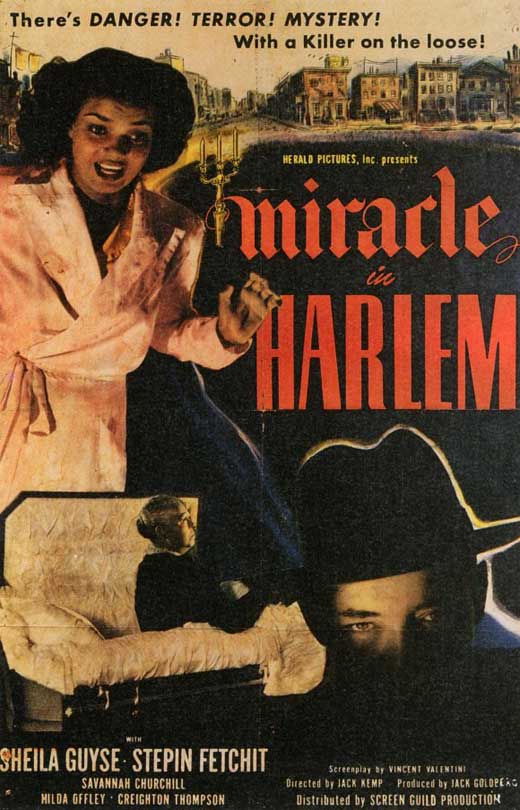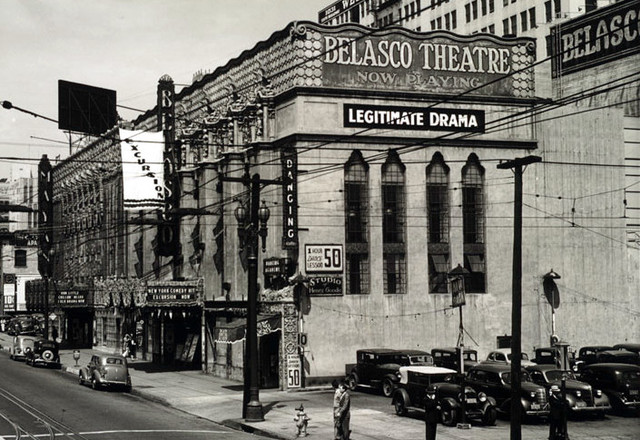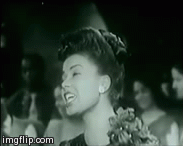I don't know if anyone else was given that title at some point, but until noted otherwise, I've taken it upon myself to dub our Star of the Month, Sheila Guyse, the Sweetheart of Race Movies.
In an era where most of America typically only got to see Black-Americans as servants, merry Southern-dwellers, and as "specialty acts" in your favorite Hollywood musicals, black filmmakers (and some white as well) were still maintaining the house that Oscar Micheaux built--creating movies specifically for Black-American audiences. A lot of these movies were musical, true, but the majority of them also provided storylines for its characters. These characters had pasts--they had futures. There was romance, drama, and suspense. These low-budget, independent movies gave black performers the kind of roles that Hollywood wouldn't. In the midst of all this emerged a young singing starlet, fresh off the nightclub circuit of Kansas City--that is Ms. Sheila Guyse.
 |
| From NY Daily News |
Sheila Guyse appeared in four of Herald Pictures' five productions--Boy! What a Girl!, Sepia Cinderella, Miracle in Harlem, and Harlem Follies of 1949. Harlem Follies is the only one of these movies that is still considered "lost", but in the other three, Ms. Guyse flawlessly embodies the "girl-next-door" archetype.
Now, as a young Black-American woman, let me tell you why Sheila Guyse and the characters she portrayed were/are important.
************
Brown Gal, Sheila Guyse
As you may have noticed by reading a few of my previous posts, colorism is one of many issues that is close to my heart. I despise the mistreatment and disregard of dark-skinned people--especially women--in the media and in society. This disrespect isn't always outright, like a tweet or a song lyric. Sometimes, it's very much..."implied"...by images on a screen. Examples: Observe the treatment of the "Patrice McDowell" character vs. the "Lisa McDowell" character in Coming to America. Also do the same with the "Sylvia Landry" and "Alma Prichard" characters in Oscar Micheaux's Within Our Gates; the "Stella" and "Anna" characters in 1958's Anna Lucasta--even the "Minnie" and "Nettie" characters in Hi-De-Ho (1947). I could go on.
 |
| From last.fm |
Sheila Guyse wasn't exactly the hue of Hattie McDaniel or Theresa Harris, but by looking at her, it's clear that she wasn't the sand-colored woman cast to make "white audiences comfortable" or to imply a higher level of education, wealth, and/or "goodness" (an "implication" that was prevalent in a lot of race movies, unfortunately: see The Scar of Shame, Within Our Gates, The Symbol of the Unconquered). Although her film career was short, Ms. Guyse was fortunate to not have to play the "the maid" like fellow brown girls Hattie McDaniel, Theresa Harris, Louise Beavers, Daisy Bufford, or Marguerite Whitten (Bufford and Whitten actually had the opportunities to play "sweetheart" or "girl next door" types in a handful of race movies, but prevalent on their long lists of credits are servant roles). She also didn't play the jealous, conniving relative/friend (the aforementioned "Alma" in Within Our Gates and "Stella" in Anna Lucasta; as well as the character of "Rusty" character in Reet, Petite, and Gone).
Mind you, this isn't a discredit to the Hatties, and Theresas; Flo Clements ("Alma Prichard") or Rosetta LeNoire ("Stella)" and their work as actresses. I'm not supporting the categorization of "good blacks vs. bad blacks" or "good girls vs. bad girls" either.
Francine, Barbara, & Julie in Love
Race movies provided black audiences with something else Hollywood couldn't/wouldn't provide them with--great love stories! In actresses like Evelyn Preer, Dorothy Van Engle, Izinetta Wilcox, and Sheila Guyse, we had "our" Mabel Normand--"our" Ginger Rogers, Claudette Colbert, and Judy Garland. Of course, there were actresses who could have been models for our love lives in the 1920s, 30s, and 40s (Nina Mae McKinney, Fredi Washington, Ethel Waters, Lena Horne)--but love was rarely a central focus in lives of the characters they played (Possible exceptions: Bessie, Petunia Jackson, Selina Rogers, Ethel Andrews, and Klili Gordon/Isabelle Walton).
 |
| From Movie Poster Shop |
What Sheila Guyse brought to mid-1940s cinema was the character of a young black woman who longed for love--and was loved. In her three starring roles, she cried over the loss of love. She fought for love. She defended and protected the men she loved. She found happiness in love. She was motivated by love. Even today, we don't see these black women on the screen often. In fact, love (lack of it or fear/rejection of it) tends to destroy us on the screen ("Chick" in Hallelujah!, "Carmen Jones", "Bess" in Porgy and Bess, "Delilah/Annie" and "Peola/Sarah Jane" in the Imitation of Life movies). Of course this isn't and wasn't always the case, but we saw/see the theme pretty often in Hollywood film and television.
"Getting the guy/girl" was something we got to see often in race movies, thankfully. However, for the women, again, love wasn't always the central focus for their characters. Their intelligence and bravery (see: Claudia and Eve Mason) often served as the central focus--another topic I'd be ecstatic to leave my typing fingers to tackle later.
Barbara got the guy in Sepia Cinderella. Julie Weston got the guy in Miracle in Harlem. Francine Cummings got a guy in Boy! What a Girl!--and nobody had to die for it to happen, either. With all of the qualities that made Sheila Guyse unique--a certain beauty, grace, and charm--she brought something to these characters that I can't imagine any other actress of the time being able to bring.
************
Make some time to discover Sheila Guyse--the "Sweetheart of Race Movies". Watch her films, listen to her album, This is Sheila (available in digital format on Amazon). Tell everyone you know about this talented woman!











